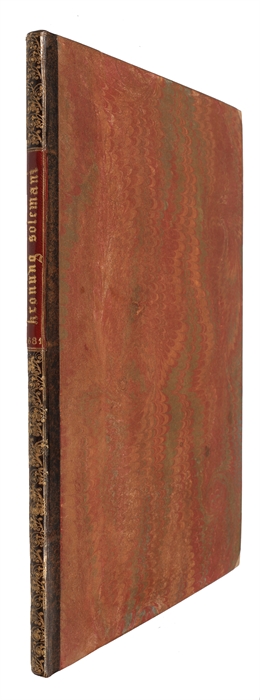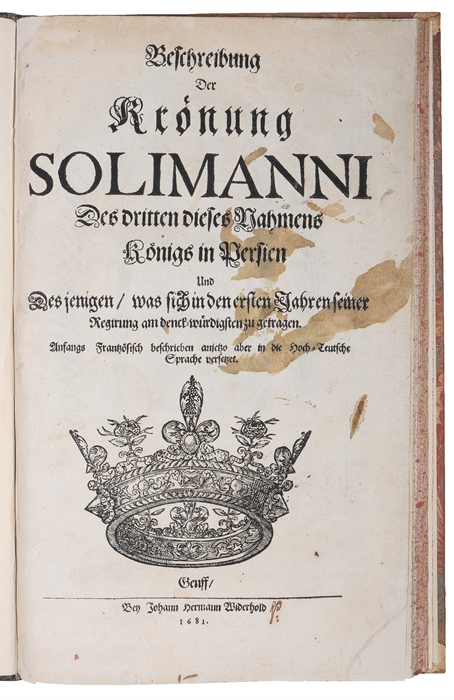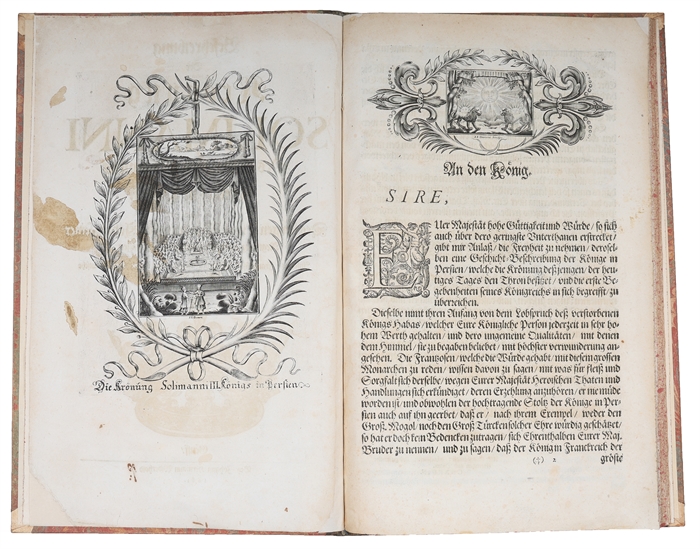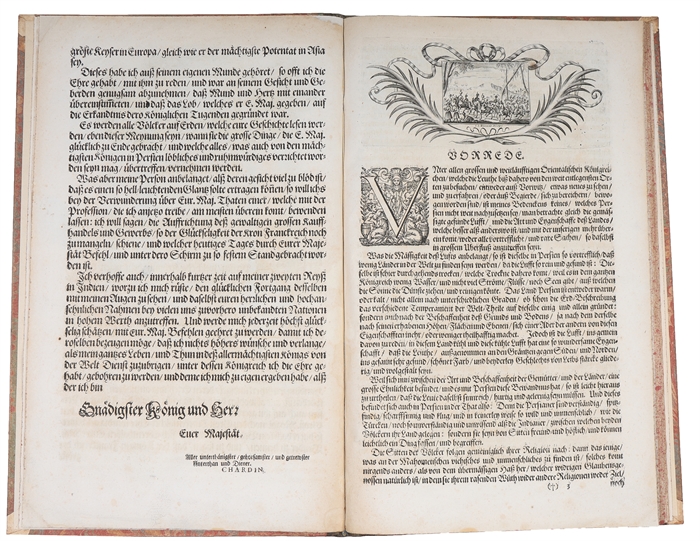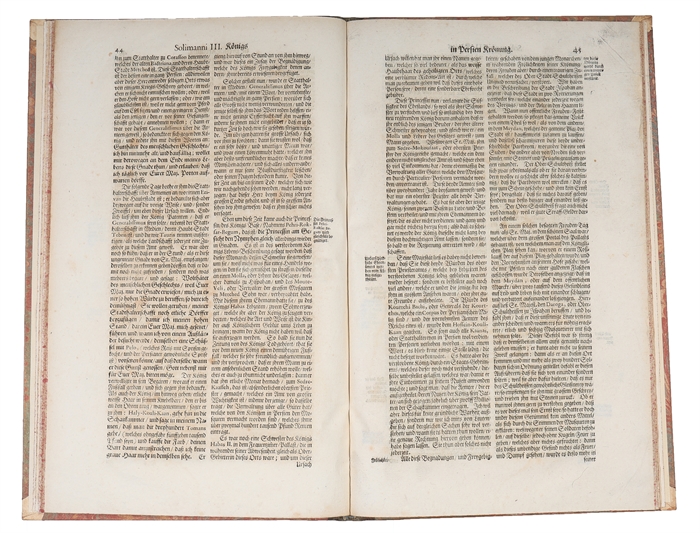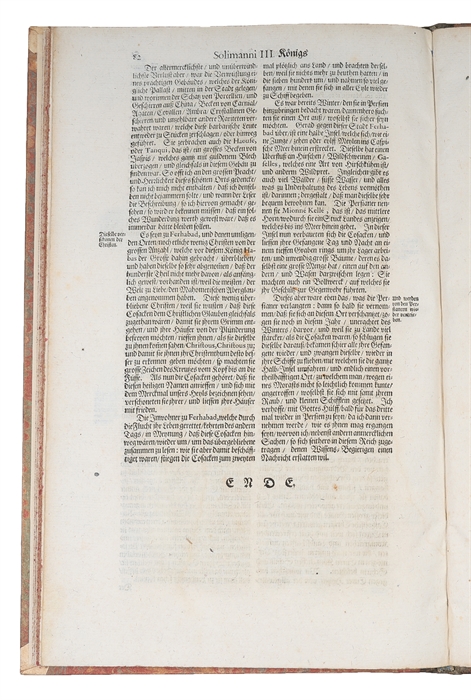EYEWITNESS ACCOUNT OF THE CORONATION OF THE EIGHTH SAHA OF SAFAVID IRAN
(CHARDIN, JEAN).
Beschreibung Der Krönung Solimanni Des dritten dieses Nahmens Königs in Persien Und Desjenigen.
Genff, Widerhold, 1681.
Folio (340 x 210 mm). Recently bound in a magnificent pastiche-binding of brown half calf with gilt red leather title-label to elaborately gilt spine. Vellum corners. Title-page with stains. A few marginal repairs, not affecting text. (8), 82 pp.
Exceedingly rare first German translation of Chardin’s “Le Couronnement de Soleimaan troisieme” (1671) - his report on the coronation of the new Persian king and what happened during the first years of his reign. Returning to Persia on the way home to Europe, Chardin witnessed the coronation of Suleiman III in 1669. Chardin’s works are considered some of the finest works of early Western scholarship on Iran and the Subcontinent in general, and the present work offered Europe a rare glimpse into the customs of the Royal house of Persia. “Chardin details the ceremonies in [the present work], with a preface that laid out the parallels between the French and Persian monarchies. Chardin portrays a filial bond between the two monarchies. The Persian shah, he declares, calls “Your Majesty [Louis XIV] his brother” due to their shared grandeur. Chardin proclaims, “The Kind of France is the greatest Emperor in Europe as he [the shah] is the most powerful Prince in Asia.” He emphasizes his admiration for Persia and its likeness to France: “Of all the vast Empires of the Orient … there is not one that should not yield to Persia, for the temperature of the air, for genius that is more reasonable than other places and is closest to our own, and for all the excellent and rare things that are found there in abundance.” (Mokhberi, The Persian Mirror) Born in Paris in a Hugenot (Protestant) family, Jean Chardin (1643-1713) undertook his travels to Persia because of his father's position as a jeweler and shareholder in the French East India Company. Chardin set out in 1664, traveling through Turkey, the Black Sea, Georgia and Armenia. Soon after his arrival in Persia he received a commission to create jewelry for Shah Abbas II, who died in 1666 and was succeeded by Shah Safi. After witnessing the latter's coronation [Described here], Chardin went on India and finally returned to Paris in 1670. In 1671, he published an account of the coronation and in the same year set off for Persia again, arriving in Isfahan in 1673 and remaining there for several years, before once more visiting India and returning home in 1677. With the persecution of the Hugenots in France, he moved to England in 1680.
"Travel restarted with 17th-century missionaries, whose medical and pedagogical expertise helped counterbalance Orthodox (or pagan) reservations. Dominican Prefects Dortelli D'Ascoli and Giovanni da Lucca (1630s) extended Giorgio Interiano's description of Circassia (and Abkhazia). Theatine proselytisers targeted Mingrelia/western Georgia (Capuchins the eastern provinces) - the Vatican's Fide Press further contributed by printing the first Georgian books (Chikobava/Vateishvili). Many, including mission-head Don Pietro Avitabile (1626-1638), recounted their experiences. Prefect to Mingrelia, Joseph Marie Zampi, a 23-year denizen from approximately 1645, contributed a third significant source in his description of Mingrelian religious practice. This he handed to Jean Chardin (1643-1713) in 1672. A French traveller who became English(!) ambassador in Holland, Chardin translated and incorporated it as a substantial part of his own description of a sometimes perilous journey through Transcaucasia (1672-3), which reflects Ottoman and Persian influence in western and eastern parts, respectively - a Turkish organized slave-trade flourished from various Mingrelian ports. Linguistically, Zampi revealingly observed that the ecclesiastical language, Georgian, was as difficult for even the Mingrelian priesthood to understand as Latin was for Italian peasants!" (Speake, The Literature of Travel and Exploration, 1, 199-202).
(Brunet I, 1802 – A later French edition).
(Graesse II, P. 121).
Order-nr.: 60953

